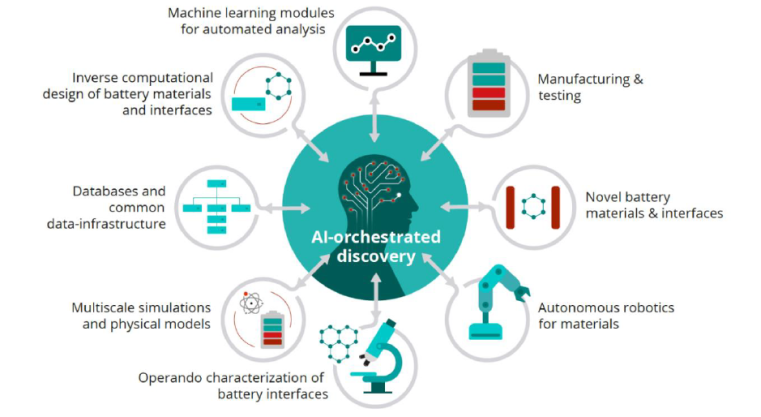Artificial intelligence expedites research on battery materials
Present societal issues as energy revolution and e-mobility challenge scientists towards rapid advancements in the way battery research is conducted today. Therefore, the concept of BIG-MAP joins complementary forces of computational and experimental methods. The project is embedded in the BATTERY 2030+ initiative and cohesively integrates machine learning (ML) accelerated simulations and artificial intelligence (AI) orchestrated experiments. Thereby, battery materials discovery and optimization can be expedited by a time factor of five to ten.
MEET Battery Research Center of WWU Münster and Helmholtz Institute Münster (HI MS) of Forschungszentrum Jülich contribute to the project with their competences in methods as High Throughput Screening (HTS) experimentation and high-level multiscale simulations. BIG-MAP proposes a worldwide unique platform in terms of fidelity, for example the ability to represent real world properties, throughput and scale.
“Genomic” knowledge through time, space and chemistries
BIG-MAP stands for “Battery Interface Genome – Materials Acceleration Platform”. The approach combines the characterization of battery electrode interfaces in time as well as in space (spatio-temporal characterization), because electrode interfaces and their interphases to the electrolyte are of the utmost importance for the operation of batteries. “The understanding, control and design concerning the function in the battery cell are key to the development of ultra-performing, smart and sustainable batteries“, underlines Prof. Martin Winter, Director of MEET and HI MS.
BIG-MAP integrates dynamic events across multiple scales, such as the atomic scale and micrometer with physical and data-driven models. Prof. Heuer from HI MS and WWU explains optimistically: “The researchers involved in BIG-MAP intend to establish a fundamental genomic knowledge of battery interfaces and interphases through time, space, and various chemistries.” The project was approved by the European Commission and the Horizon 2020 Framework Programme at the end of March 2020.
Conceptual flow
Too many different possibilities to change battery characteristics in the laboratory make a systematic trial and error approach impossible. This is where ML steps in. By active learning the computer is able to recognize underlying structures in large data volumes from experiments and simulations. Thereby, promising material combinations are suggested automatically in the “chemical space” and the development process is accelerated significantly. For this AI-orchestrated approach a highly efficient data management as part of the BIG-MAP platform is required.

The illustration shows the large number modules in BIG-MAP, which are intertwined via the KI. This reflects the ideal conception of an autonomous laboratory for the optimization of development processes via a large number of feedback loops.
A kick-off meeting is planned for 5th to 6th October 2020 in Copenhagen. By this, the first project phase of three years will begin. In total BIG-MAP is designed to run for ten years. The novel approach is supposed to transform partners in industry and academia into a unified world leading research and development community.

